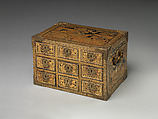Nanban Cabinet with Drawers
Not on view
In the second half of the sixteenth century, Japanese lacquer made for Western markets was known as Nanban (Southern Barbarian) lacquer, a reference to the epithet given to foreigners from Spain, Portugal, and the Netherlands. Many of these export lacquers were made in Kyoto. Six-drawer cabinets of this type, listed in European collections as secrétaires or comptoiren, would generally have had a fall-front door. One of the earliest examples of an export cabinet without a fall front was inventoried at Schloss Ambras in Austria, around 1607. The drawer fronts of this sumptuous, small, and richly embellished cabinet are densely decorated with autumn flowers and shells, while geometric patterns, floral designs, and repeated intersecting-circle motifs (shippo) embellish the dividers. The top and sides display complex compositions inspired by Japanese literary classics. The unusual size and iconography of the cabinet indicate that it could have been a special order.
This image cannot be enlarged, viewed at full screen, or downloaded.
This artwork is meant to be viewed from right to left. Scroll left to view more.



